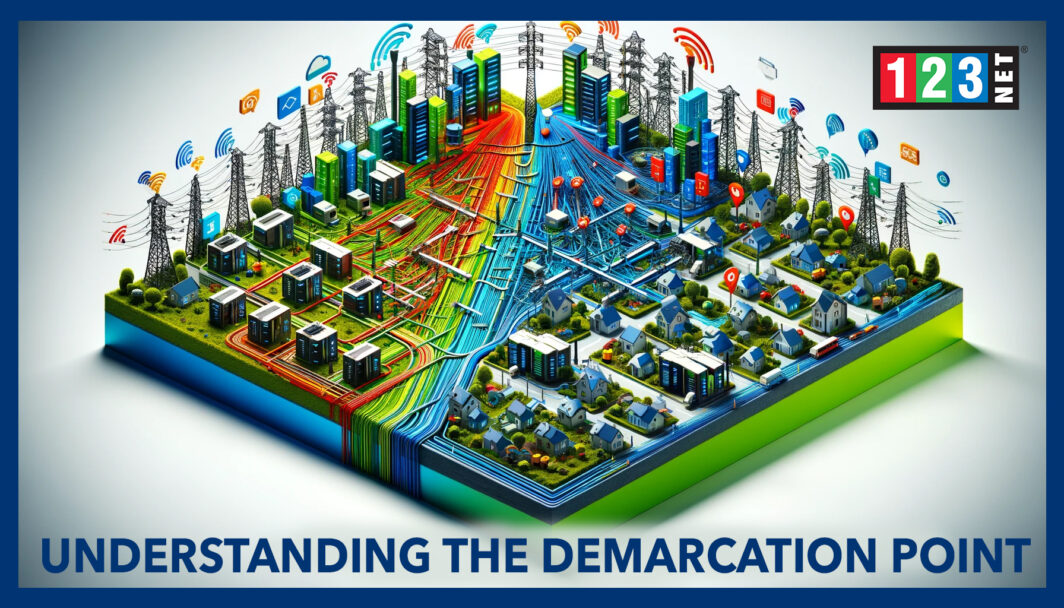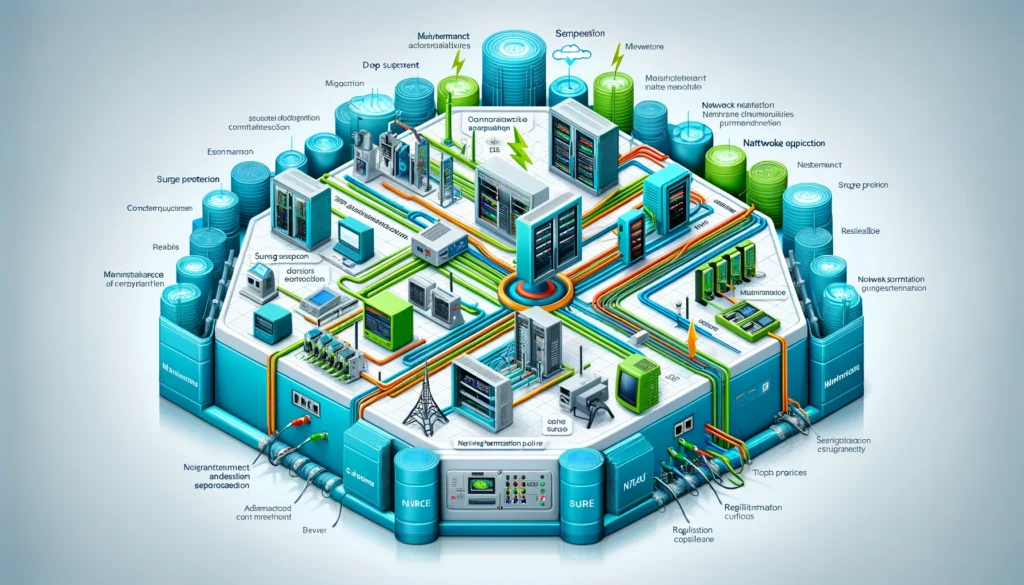
Introduction
The telecommunications sphere is intricate, with the demarcation point being crucial. It marks the boundary between the service provider’s public network and the customer’s private network. Often referred to as “demarc,” it signifies where the Public Switched Telephone Network (PSTN) concludes and the private network starts. Grasping the concept of the demarcation point is vital for those involved in telecommunications management or setup. It delineates the responsibilities for maintenance, troubleshooting, and enhancements. This clear division aids in understanding who is accountable for various aspects of the network. Ensuring clarity, the demarcation point helps prevent disputes over network issues. It’s a fundamental concept for ensuring smooth operation and efficient problem resolution in telecommunications systems.
What is a Demarcation Point or Demarc?
A demarcation point, known as a demarc, represents a critical physical boundary. It’s where the telecommunications provider’s external wiring connects with a property’s internal systems. This junction symbolizes the shift in network responsibility from the service provider to either the building owner or the tenant. In homes, the Network Interface Device (NID) usually marks this spot, often mounted on the exterior. Businesses, however, might locate their demarc within a dedicated telecommunications closet or room, identified by either a Smartjack or an Optical Network Terminal (ONT) for those with fiber connections.
The importance of the demarcation point stretches beyond merely delineating boundaries. It plays a pivotal role in determining responsibility for maintenance and repairs on both sides of this line. Furthermore, it aids in troubleshooting efforts, enabling technicians to pinpoint whether issues originate from the service provider’s network or the customer’s own internal setup. By clearly defining this boundary, it ensures a smoother resolution process for network-related problems.
Understanding the demarcation point is essential for anyone involved in property management, telecommunications, or IT support. It informs decisions about upgrades, expansions, and network enhancements. Moreover, it helps in setting clear expectations regarding who handles specific types of network issues, which is crucial for efficient problem solving and maintenance. This knowledge is invaluable for ensuring the reliability and performance of both public and private network segments. It underscores the collaborative relationship between telecommunications providers and their customers, facilitating a better understanding and management of the interconnected networks that power our communications infrastructure.
A Brief History of the Demarcation Point
The demarcation point’s concept has matured with the telecommunications sector. Its roots are in the Modified Final Judgment (MFJ) of 1982, ending the antitrust case against AT&T. This judgment prompted AT&T’s local services division and led to the Regional Bell Operating Companies (RBOC) formation. The MFJ required a distinct demarcation point to foster competition and define responsibilities between these new entities and their clients. This pivotal moment highlighted the demarcation point’s significance in today’s telecom field.
The demarcation point’s establishment was crucial for delineating network responsibility zones. It facilitated clearer service boundaries, ensuring both providers and customers knew where their maintenance duties began and ended. This clarity has been vital for the growth and evolution of telecommunications, enabling more efficient network management and troubleshooting. As technology advanced, the demarcation point adapted, reflecting changes in network infrastructure and customer needs. Its history reflects broader industry shifts, underscoring its enduring relevance in defining the interplay between public and private network responsibilities. This development has not only shaped regulatory frameworks but also influenced how services are delivered and managed across the telecommunications landscape.

Uses of a Demarcation Point
The demarcation point plays multiple vital roles in telecommunications. It clearly marks where network maintenance and repair responsibilities are divided: the customer handles their side, and the service provider manages up to the demarc. This division is crucial for resolving issues swiftly and maintaining the network effectively.
Protects Internal Network
Additionally, the demarcation point includes surge suppressors, protecting the internal network from electrical surges. This feature boosts both network reliability and safety. It also supports fault propagation, which enables the rapid detection and isolation of network problems, essential for uninterrupted service.
Hosts a NTU
In environments utilizing Integrated Services Digital Network (ISDN) and other advanced telecommunications services, the demarcation point might host a Network Termination Unit (NTU). This inclusion somewhat complicates the public-private network responsibility demarcation but always with the goal of improving service provision and network management.
Regulatory Compliance & Quality
Understanding the demarcation point’s functions is key for anyone involved in telecommunications. It not only ensures network integrity and facilitates troubleshooting but also plays a significant role in regulatory compliance and service quality. The equipment at the demarc, like surge protectors and NTUs, reflects the industry’s commitment to safeguarding and optimizing network connections.
This boundary point has evolved to accommodate technological advancements, becoming more complex but also more capable. It symbolizes the collaborative effort between service providers and customers to maintain a robust telecommunications infrastructure. As technologies advance, the demarcation point’s role will likely continue to expand, adapting to new challenges and opportunities in the telecommunications landscape.
Different Types of Demarcs
The demarcation device type can differ, depending on the service and technology in use. For traditional phone services, the Network Interface Device (NID) is typical, acting as the demarcation point. It is a straightforward, weather-resistant box that contains the connection between external and internal wiring.
Digital and High-Capacity
Digital and high-capacity services frequently utilize a Smartjack. This sophisticated device serves as a demarcation point while offering diagnostic functions and additional service features, especially beneficial for T1 lines and other fast connections.
Optical and Electrical Signals
In fiber-optic networks, the demarcation point role shifts to the Optical Network Terminal (ONT). It transforms the optical signal to electrical signals for phone, internet, and TV services, catering to the high-speed needs of contemporary telecommunications networks.
Understanding these devices is crucial for network setup and troubleshooting. Each type of demarcation device facilitates specific telecommunications services, ensuring the network meets performance standards. The NID, Smartjack, and ONT each play unique roles in connecting and protecting the network, demonstrating the evolution of telecommunications technology.
These devices not only mark the boundary of network responsibility but also enhance network reliability and service quality. As telecommunications infrastructure advances, the significance of selecting the appropriate demarcation device grows. This choice impacts network efficiency, maintenance, and the ability to swiftly address issues, underscoring the importance of demarcation devices in the modern digital landscape. Their role in defining network boundaries and facilitating high-quality telecommunications services is a testament to the critical nature of these devices in ensuring seamless connectivity.

Global Demarcation Standards
The demarcation point concept is globally recognized, yet its actual application differs across countries, shaped by various regulatory standards and practices. In the United States, the Federal Communications Commission (FCC) regulates telecommunications standards, including demarcation points. These standards ensure a safe connection between the Public Switched Telephone Network (PSTN) and customer premises equipment.
Countries like the United Kingdom and Canada have their own sets of regulations and standards for demarcation points. These are tailored to meet the specific needs and challenges of their telecommunications infrastructures. This variation underscores the importance of understanding local regulations for those involved in telecommunications.
These differing approaches to demarcation points reflect the diversity in global telecommunications policies. They also highlight the necessity for international companies to adapt their practices to comply with local regulations. Despite these differences, the fundamental purpose of demarcation points—clarifying the division of network responsibility—remains constant worldwide.
Adapting to these various standards is crucial for ensuring network integrity and efficiency across borders. It also facilitates the global connectivity that modern economies and societies rely on. Thus, while the core idea of a demarcation point is universal, its specific implementation is a reflection of each country’s approach to managing and regulating its telecommunications infrastructure.
Demarcation Point FAQs
- How much does a demarcation point extension cost? A: Costs can vary widely based on the complexity of the extension and local rates, but small business extensions typically start around $300.
- Can I perform basic maintenance myself? A: Yes, property owners can usually perform basic maintenance on their side of the demarcation point, although anything beyond simple troubleshooting should be handled by professionals.
- Who can I contact to repair wiring issues on my side of the point? A: While you’re not obligated to use your service provider for repairs on your side, many offer maintenance plans. Alternatively, licensed telecommunications technicians can perform these services.
Choosing the Right Business Phone System
Grasping the demarcation point’s concept is key in choosing a business phone system. Whether it’s the traditional Plain Old Telephone Service (POTS) or a contemporary Voice Over Internet Protocol (VoIP) setup, understanding the demarcation point’s location and associated responsibilities is pivotal. This knowledge impacts installation processes, ongoing maintenance, and the scope for future enhancements. It’s a vital factor for businesses preparing to establish or update their telecommunications framework.
Knowing where the demarcation point lies helps in planning network layouts and foreseeing the division of network management duties. This clarity can greatly influence your selection, leaning towards solutions that offer ease of management and scalability. For businesses, this understanding ensures a smoother integration of new technologies and easier troubleshooting.
Additionally, awareness of demarcation points can lead to more informed discussions with service providers, enabling businesses to negotiate better terms for service levels and support. It becomes an integral part of strategic planning for telecommunications, ensuring businesses are well-equipped to handle both current needs and future growth.
Thus, the demarcation point not only affects technical aspects of a phone system but also plays a crucial role in a business’s telecommunications strategy. This makes it an indispensable consideration for any company aiming to leverage telecommunications for operational efficiency and growth.
Conclusion
The demarcation point is a fundamental concept in telecommunications, serving as the critical boundary between public and private networks. Its understanding is essential for anyone involved in the planning, maintenance, or management of telecommunications systems. By clarifying responsibilities, protecting networks, and facilitating troubleshooting, the demarcation point ensures the efficient and reliable delivery of telecommunications services.




